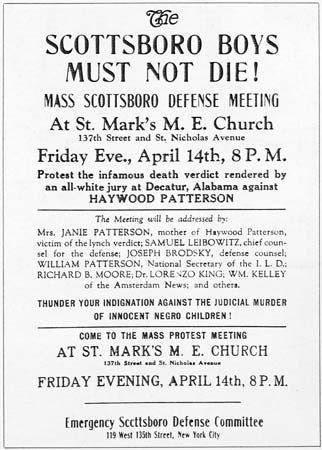Scottsboro case
United States history
 major U.S. civil rights controversy of the 1930s surrounding the prosecution in Scottsboro, Ala., of nine black youths charged with the rape of two white women. The nine, after nearly being lynched, were brought to trial in Scottsboro in April 1931 just three weeks after their arrest. Not until the first day of the trial were the defendants provided with the services of two volunteer lawyers.
major U.S. civil rights controversy of the 1930s surrounding the prosecution in Scottsboro, Ala., of nine black youths charged with the rape of two white women. The nine, after nearly being lynched, were brought to trial in Scottsboro in April 1931 just three weeks after their arrest. Not until the first day of the trial were the defendants provided with the services of two volunteer lawyers.Despite testimony by doctors who had examined the women that no rape had occurred, the all-white jury convicted the nine, and all but the youngest, who was 12 years old, were sentenced to death. The announcement of the verdict and sentences brought a storm of charges from outside the South that a gross miscarriage of justice had occurred in Scottsboro. The cause of the “Scottsboro Boys” was championed, and in some cases exploited, by Northern liberal and radical groups, notably the Communist Party of the U.S.A.
In 1932 the U.S. Supreme Court overturned the convictions (Powell v. Alabama) on the grounds that the defendants had not received adequate legal counsel in a capital case. The state of Alabama then retried one of the accused and again convicted him. In a 1935 decision (Norris v. Alabama), the U.S. Supreme Court overturned this conviction, ruling that the state had systematically excluded blacks from juries.
Alabama again tried and convicted another of the group, Haywood Patterson, this time sentencing him to 75 years in prison. Further trials of the rest of the defendants resulted in more reconvictions and successful appeals until, after persistent pressure from citizens' groups, the state freed the four youngest (who had already served six years in jail) and later paroled all but Patterson. Patterson escaped in 1948 and fled to Michigan, where, three years later, he was convicted of manslaughter in the stabbing death of another black. He died in prison.
The last known surviving member of the group, Clarence Norris, who had fled North after his parole in 1946, was granted a full pardon by the Governor of Alabama in 1976.
- Lee, Ang
- Lee, Ann
- Lee, Arthur
- Lee Bontecou
- Lee Calhoun
- leech
- leeching
- Leech, John
- Lee Commission
- Lee, David M.
- Lee De Forest
- Leeds
- Leeds, Thomas Osborne, 1st Duke of, Marquess of Carmarthen, Earl of Danby, Viscount Latimer of Danby, Viscount Osborne of Dunblane, Baron Osborne of Kiveton
- LEED® standards
- Lee-Enfield rifle
- Lee Evans
- Lee, Gypsy Rose
- Lee, Harper
- Lee Harvey Oswald
- Lee, Henry
- Lee Iacocca
- Lee, Ivy Ledbetter
- Lee, Jennie, Baroness of Asheridge
- Lee, John Clifford Hodges
- leek